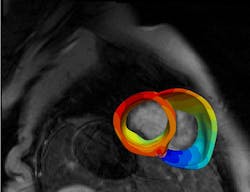Johns Hopkins method outperforms previous approaches for assessing risk in cardiac sarcoidosis
Johns Hopkins University scientists have developed a new tool for predicting which patients suffering from a complex inflammatory heart disease are at risk of sudden cardiac arrest. Published in Science Advances, their method is the first to combine models of patients’ hearts built from multiple images with the power of machine learning.
“This robust new personalized technology outperformed clinical metrics in forecasting future arrhythmia and could transform the management of cardiac sarcoidosis patients,” said senior author Natalia Trayanova, a Johns Hopkins professor of biomedical engineering and co-director of the Alliance for Cardiovascular Diagnostic and Treatment Innovation (ADVANCE).
Doctors don’t currently have precise methods for assessing which patients with cardiac sarcoidosis, a condition causing inflammation and scarring that can trigger irregular heartbeats, are likely to have a fatal arrthmia, meaning that some patients don’t survive, while others undergo unnecessary, invasive interventions. A recent meta-analysis cited in the study found that roughly only one third of CS patients receive adequate treatment.
“There is an urgent clinical need for better predictive tools,” said Trayanova, who is also a professor at the Johns Hopkins School of Medicine. “Some CS patients perish, often in the prime of their life, while others have a defibrillator implanted unnecessarily and often deal with the complications, including infections, device malfunction, and inappropriate shocks, without receiving any real benefit.”
In their study, the researchers created digital three-dimensional models of the hearts of 45 CS patients treated at the Johns Hopkins Hospital. To do this, they took the novel approach of combining data from two different kinds of heart scans: contrast-enhanced cardiac MRIs, which detect fibrosis, or scarring, and PET scans, which detect inflammation. The team used computer simulations to apply a series of electrical signals at various locations throughout each of the models and gathered millions of data points measuring each heart’s reaction.
The tool significantly outperformed standard clinical metrics for predicting cardiac arrest in CS patients.
“We were able to estimate the tool’s accuracy for new patients with 95 percent confidence, meaning we were relatively certain the algorithm wouldn’t be biased by the data it was trained with and that it would therefore be accurate when applied to new patients,” said Shade.
Lastly, the team compared their simulations against scans of lesions in the hearts of the patients who had subsequently undergone a procedure to reset their heartbeats, finding that their predictions were consistent with actual outcomes.
Visit Johns Hopkins University for more